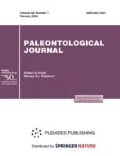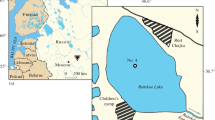Abstract
Detailed palynological analysis of glacial, tectonic, and crater lakes of northeastern Siberia reveals continuous records of the changing vegetation during one or several climatic cycles of the Pleistocene and in the Holocene. The most continuous records in the mountain areas of the region are those of Lake Elikchan-4 (northern Okhotsk Sea Region). Pollen records of Lake El’gygytgyn, which was formed by the impact of a meteorite in the northern Chukchi Peninsula, reflect the response of land vegetation to the global climatic impact during the last 300 ka.
Similar content being viewed by others
References
L. B. Brubaker, P. M. Anderson, M. E. Edwards, and A. V. Lozhkin, “Beringia As a Glacial Refugium for Boreal Trees and Shrubs: New Perspectives from Mapped Pollen Data,” J. Biogeogr., No. 32, 833–848 (2005).
A. V. Lozhkin, “Problems in the Geochronology and Paleogeography of the Quaternary Period of the Northeastern USSR,” in Geology of the Continent-Ocean Transition Zone in Northeastern Asia (Severo-Vostochn. Kompleksn. Nauchno-Issled. Inst. Dal’nevost. Otd. Ross. Akad. Nauk, Magadan, 1991), pp. 47–59 [in Russian].
A. V. Lozhkin, P. M. Anderson, and T. V. Matrosova, “Volcanic Ash in the Sediments of Lakes in Northeastern Siberia,” in Climatic Records in the Quaternary Sediments of Beringia (Severo-Vostochn. Kompleksn. Nauchno-Issled. Inst. Dal’nevost. Otd. Ross. Akad. Nauk, Magadan, 2004), pp. 108–113 [in Russian].
J. T. Overpeck, I. C. Prentice, and T. Webb, “Quantitative Interpretation of Fossil Pollen Spectra: Dissimilarity Coefficients and the Method of Modern Analog,” Quaternary Res., No. 23, 87–108 (1985).
N. A. Shilo, A. V. Lozhkin, E. E. Titov, and Yu. V. Shumilov, Kirgilyakh Mammoth (Paleogeographic Aspect) (Nauka, Moscow, 1983) [in Russian].
“The Glaciation of the Anadyr Lowland (Based on Lake Sediments),” in Pages of the Quaternary History of Northeastern Asia, Ed. by A. V. Lozhkin, P. M. Anderson, T. A. Braun, et al. (Severo-Vostochn. Kompleksn. Nauchno-Issled. Inst. Dal’nevost. Otd. Ross. Akad. Nauk, Magadan, 2005) [in Russian].
The Late Quaternary Vegetation and Climates in Siberia and in the Russian Far East (Palynological and Radiocarbon Database), Ed. by P. M. Anderson and A. V. Lozhkin (Severo-Vostochn. Tsentr Dal’nevost. Otd. Ross. Akad. Nauk, Magadan, 2002), p. 370 [in Russian and English].
Author information
Authors and Affiliations
Rights and permissions
About this article
Cite this article
Lozhkin, A.V., Anderson, P.A. A reconstruction of the climate and vegetation of northeastern Siberia based on lake sediments. Paleontol. J. 40 (Suppl 5), S622–S628 (2006). https://doi.org/10.1134/S0031030106110098
Received:
Issue Date:
DOI: https://doi.org/10.1134/S0031030106110098




